
The Agaricales are an order of fungi in the division Basidiomycota. As originally conceived, the order contained all the agarics, but subsequent research has shown that not all agarics are closely related and some belong in other orders, such as the Russulales and Boletales. Conversely, DNA research has also shown that many non-agarics, including some of the clavarioid fungi and gasteroid fungi belong within the Agaricales. The order has 46 extant families, more than 400 genera, and over 25,000 described species, along with six extinct genera known only from the fossil record. Species in the Agaricales range from the familiar Agaricus bisporus and the deadly Amanita virosa to the coral-like Clavaria zollingeri and bracket-like Fistulina hepatica.

The Strophariaceae are a family of fungi in the order Agaricales. Under an older classification, the family covered 18 genera and 1316 species. The species of Strophariaceae have red-brown to dark brown spore prints, while the spores themselves are smooth and have an apical germ pore. These agarics are also characterized by having a cutis-type pileipellis. Ecologically, all species in this group are saprotrophs, growing on various kinds of decaying organic matter. The family was circumscribed in 1946 by mycologists Rolf Singer and Alexander H. Smith.

The Hygrophoraceae are a family of fungi in the order Agaricales. Originally conceived as containing white-spored, thick-gilled agarics, including Hygrophorus and Hygrocybe species, DNA evidence has extended the limits of the family, so it now contains not only agarics, but also basidiolichens and corticioid fungi. Species are thus diverse and are variously ectomycorrhizal, lichenized, associated with mosses, or saprotrophic. The family contains 34 genera and over 1000 species. None is of any great economic importance, though fruit bodies of some Hygrocybe and Hygrophorus species are considered edible and may be collected for sale in local markets.

Hygrocybe is a genus of agarics in the family Hygrophoraceae. Called waxcaps in English, basidiocarps are often brightly coloured and have dry to waxy caps, white spores, and smooth, ringless stems. In Europe they are characteristic of old, unimproved grasslands which are a declining habitat, making many Hygrocybe species of conservation concern. Four of these waxcap-grassland species, Hygrocybe citrinovirens, H. punicea, H. spadicea, and H. splendidissima, are assessed as globally "vulnerable" on the IUCN Red List of Threatened Species. Elsewhere waxcaps are more typically found in woodlands. Most are ground-dwelling and all are believed to be biotrophs. Around 150 species are recognized worldwide. Fruit bodies of several Hygrocybe species are considered edible and are sometimes offered for sale in local markets.
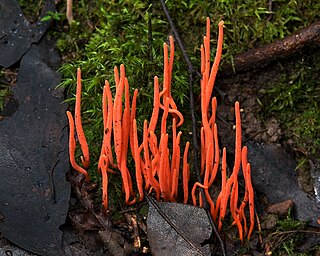
The Clavariaceae are a family of fungi in the order Agaricales. Originally the family contained most of the clavarioid fungi, but in its current sense is more restricted, albeit with a greater diversity of basidiocarp forms. Basidiocarps are variously clavarioid or agaricoid (mushroom-shaped), less commonly corticioid or hydnoid.

The Tricholomataceae are a large family of fungi within the order Agaricales. Originally a classic "wastebasket taxon", the family included any white-, yellow-, or pink-spored genera in the Agaricales not already classified as belonging to e.g. the Amanitaceae, Lepiotaceae, Hygrophoraceae, Pluteaceae, or Entolomataceae.

Cuphophyllus is a genus of agaric fungi in the family Hygrophoraceae. Cuphophyllus species belong to a group known as waxcaps in English, sometimes also waxy caps in North America or waxgills in New Zealand. In Europe, Cuphophyllus species are typical of waxcap grasslands, a declining habitat due to changing agricultural practices. As a result, four species, Cuphophyllus atlanticus, C. colemannianus, C. lacmus, and C. lepidopus are of global conservation concern and are listed as "vulnerable" on the IUCN Red List of Threatened Species.
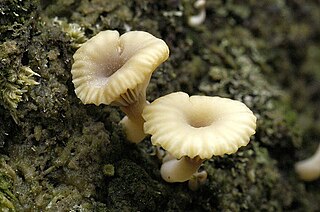
Lichenomphalia is both a basidiolichen and an agaric genus. Most of the species have inconspicuous lichenized thalli that consist of scattered, small, loose, nearly microscopic green balls or foliose small flakes containing single-celled green algae in the genus Coccomyxa, all interconnected by a loose network of hyphae. The agaric fruit bodies themselves are nonlichenized and resemble other types of omphalinoid mushrooms. These agarics lack clamp connections and do not form hymenial cystidia. The basidiospores are hyaline, smooth, thin-walled, and nonamyloid. Most of the species were originally classified in the genera Omphalina or Gerronema. Historically the species were classified with those other genera in the family, the Tricholomataceae together with the nonlichenized species. Lichenomphalia species can be grouped into brightly colored taxa, with vivid yellow and orange colors, versus the grey brown group, depending upon the microscopic pigmentation deposits. Molecular research comparing DNA sequences now place Lichenomphalia close to the redefined genus Arrhenia, which together with several other genera not traditionally considered to be related, fall within the newly redefined Hygrophoraceae.

The Hymenogastraceae is a family of fungi in the order Agaricales with both agaric and false-truffle shaped fruitbodies. Formerly, prior to molecular analyses, the family was restricted to the false-truffle genera. The mushroom genus Psilocybe in the Hymenogastraceae is now restricted to the hallucinogenic species while nonhallucinogenic former species are largely in the genus Deconica classified in the Strophariaceae.
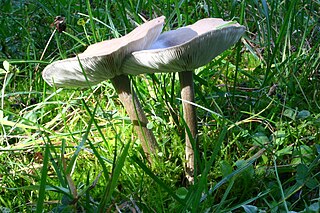
Melanoleuca is a poorly known genus of saprotrophic mushrooms traditionally classified in the family Tricholomataceae. Most are small to medium sized, white, brown, ocher or gray with a cylindrical to subcylindrical stipe and white to pale yellowish gills. The basidiospores are ellipsoid and ornamented with amyloid warts. Melanoleuca is considered a difficult group to study due to their macroscopic similarities among species and the need of a thorough microscopic analysis to separate species. DNA studies have determined that this genus is closely related to Amanita and Pluteus and that it does not belong to the family Tricholomataceae.
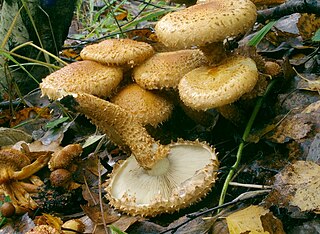
Pholiota is a genus of small to medium-sized, fleshy mushrooms in the family Strophariaceae. They are saprobes that typically live on wood. The genus has a widespread distribution, especially in temperate regions, and contains about 150 species.
Aeruginospora is a genus of fungi in the family Hygrophoraceae. It was formerly placed in the family Tricholomataceae, but it was moved to the Hygrophoraceae in a recent review of the family based on its morphological similarity to Chrysomphalina and especially Haasiella. It might be that Haasiella, which differs in spore color and ecology, is a junior synonym of Aeruginospora, but this has not yet been tested in a molecular phylogenetics study. The genus, described by Franz Xaver Rudolf von Höhnel in 1908, currently contains two species found in New Zealand and Indonesia. Six species formerly placed in Aeruginospora were transferred to the genus Camarophyllopsis. A. furfuracea might also belong in Camarophyllopsis, but it has not yet been restudied.

Pseudoomphalina is a genus of fungi in the placed in the family Tricholomataceae for convenience. The genus contains six species that are widespread in northern temperate areas. Pseudoomphalina was circumscribed by Rolf Singer in 1956. Pseudoomphalina was found to be paraphyletic to Neohygrophorus in a molecular phylogenetics study and since Pseudoomphalina is an older name, Neohygrophyorus was synonymized with it. The type species of Neohygrophorus was Neohygrophorus angelesianus, now Pseudoomphalina angelesiana. In earlier classifications based on anatomy prior to DNA sequence-based classifications, its unusual combination of features led taxonomists to independently create two subgenera in two genera: Hygrophorus subg. Pseudohygrophorus and Clitocybe subg. Mutabiles; the latter based on Neohygrophorus angelesianus but described under a new species name which is now placed in synonymy, Clitocybe mutabilis. All species of Pseudoomphalina are united by the presence of clamp-connections in their hyphae, an interwoven gill trama and amyloid spores. Pseudoomphalina angelesiana possesses grey-violaceous pigments that turn red in alkali solutions and lacks filiform, hyphal sterile elements in its hymenium and stipitipellis. These were features used to distinguish it from Pseudoomphalina as a genus, but Pseudoomphalina umbrinopurpurascens possesses these same pigments and the filiform elements of Pseudoomphalina. Molecular phylogenetics studies have also found some former species of Pseudoomphalina to belong in other genera. Pseudoomphalina pachyphylla was moved to its own genus, Pseudolaccaria, and Pseudoomphalina clusiliformis was synonymized with it. Pseudoomphalina flavoaurantia and Pseudoomphalina lignicola were found to belong in Clitocybula. Phylogenetically, Pseudoomphalina is in a tricholomatoid clade but not in the Tricholomataceae.
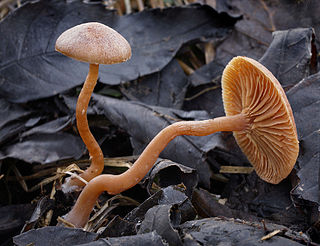
Tubaria is a genus of fungi in the family Tubariaceae. The genus is widely distributed, especially in temperate regions. Tubaria was originally named as a subgenus of Agaricus by Worthington George Smith in 1870. Claude Casimir Gillet promoted it to generic status in 1876. The mushrooms produced by species in this genus are small- to medium-sized with caps ranging in color from pale pinkish-brown to reddish-brown, and often with remnants of the partial veil adhering to the margin. Mushrooms fruit on rotting wood, or, less frequently, in the soil. There are no species in the genus that are recommended for consumption.

Gliophorus is a genus of agaric fungi in the family Hygrophoraceae. Gliophorus species belong to a group known as waxcaps in English, sometimes also waxy caps in North America or waxgills in New Zealand. In Europe, Gliophorus species are typical of waxcap grasslands, a declining habitat due to changing agricultural practices. As a result, two species, Gliophorus europerplexus and Gliophorus reginae, are of global conservation concern and are listed as "vulnerable" on the IUCN Red List of Threatened Species.

Aphroditeola is an agaric fungal monotypic genus that produces pink cantharelloid fruit bodies on coniferous forest floors. The lamellae are forked and typically the fruit bodies have a fragrant odor described as candy-like, cinnamon-like or pink bubble gum-like.
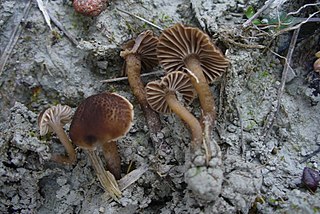
Hodophilus is a genus of agarics in the family Clavariaceae. Basidiocarps are dull-coloured and have dry caps, rather distant, decurrent lamellae, white spores, and smooth, ringless stems. In Europe species are characteristic of old, unimproved grasslands which are a declining habitat, making them of conservation concern. Several species have a distinct odour of naphthalene.
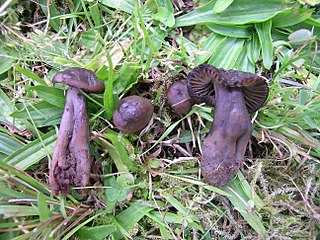
Neohygrocybe is a genus of agaric fungi in the family Hygrophoraceae. Neohygrocybe species belong to a group known as waxcaps in English, sometimes also waxy caps in North America or waxgills in New Zealand. In Europe, Neohygrocybe species are typical of waxcap grasslands, a declining habitat due to changing agricultural practices. As a result, three species, Neohygrocybe ingrata, Neohygrocybe nitrata, and Neohygrocybe ovina, are of global conservation concern and are listed as "vulnerable" on the IUCN Red List of Threatened Species.

















